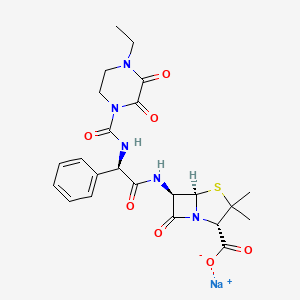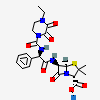Piperacillin Sodium
- PIPERACILLIN SODIUM
- 59703-84-3
- PIPERACILLIN SODIUM SALT
- Pipracil
- Sodium piperacillin
- Create:2008-02-05
- Modify:2025-01-04

- AB Piperacillin
- AB-Piperacillin
- Cl 227193
- Cl-227193
- Cl227193
- Curasan, Piperacillin
- Monosodium Salt, Piperacillin
- Pipcil
- Pipera hameln
- Pipera-hameln
- Piperacillin
- Piperacillin curasan
- Piperacillin Fresenius
- Piperacillin Hexal
- Piperacillin Monosodium Salt
- Piperacillin ratiopharm
- Piperacillin Sodium
- Piperacillin-ratiopharm
- Pipercillin
- Pipracil
- Pipril
- Salt, Piperacillin Monosodium
- Sodium, Piperacillin
- T 1220
- T-1220
- T1220
- PIPERACILLIN SODIUM
- 59703-84-3
- PIPERACILLIN SODIUM SALT
- Pipracil
- Sodium piperacillin
- Penmalin
- Pentcillin
- Piperacillin (sodium)
- Piperacillin (as sodium)
- UNII-M98T69Q7HP
- CCRIS 2591
- CHEBI:8233
- M98T69Q7HP
- EINECS 261-868-6
- MFCD00917471
- T-1220
- Cl-227193
- NSC-757277
- MLS000069533
- CL 227,193
- DTXSID6048965
- Piperacillin sodium [USAN:USP:JAN]
- NSC 757277
- 4-Thia-1-azabicyclo[3.2.0]heptane-2-carboxylic acid, 6-[[(2R)-2-[[(4-ethyl-2,3-dioxo-1-piperazinyl)carbonyl]amino]-2-phenylacetyl]amino]-3,3-dimethyl-7-oxo-, sodium salt (1:1), (2S,5R,6R)-
- SMR000058579
- ZOSYN COMPONENT PIPERACILLIN SODIUM
- Sodium (2S,5R,6R)-6-((R)-2-(4-ethyl-2,3-dioxo-1-piperazinecarboxamido)-2-phenylacetamido)-3,3-dimethyl-7-oxo-4-thia-1-azabicyclo(3.2.0)heptane-2-carboxylate
- sodium;(2S,5R,6R)-6-[[(2R)-2-[(4-ethyl-2,3-dioxopiperazine-1-carbonyl)amino]-2-phenylacetyl]amino]-3,3-dimethyl-7-oxo-4-thia-1-azabicyclo[3.2.0]heptane-2-carboxylate
- Sodium;(2S,5R,6R)-6-[[(2S)-2-[(4-ethyl-2,3-dioxopiperazine-1-carbonyl)amino]-2-phenylacetyl]amino]-3,3-dimethyl-7-oxo-4-thia-1-azabicyclo[3.2.0]heptane-2-carboxylate
- Pipracil Sterile
- Piperacillin sodium (USAN:USP:JAN)
- PIPERACILLIN SODIUM (EP MONOGRAPH)
- PIPERACILLIN SODIUM [EP MONOGRAPH]
- Sodium (2S,5R,6R)-6-((R)-2-(4-ethyl-2,3-dioxopiperazine-1-carboxamido)-2-phenylacetamido)-3,3-dimethyl-7-oxo-4-thia-1-azabicyclo[3.2.0]heptane-2-carboxylate
- PIPERACILLIN SODIUM (USP MONOGRAPH)
- PIPERACILLIN SODIUM [USP MONOGRAPH]
- Sodium, Piperacillin
- T 1220
- DTXCID3028891
- Piperacillin Monosodium Salt
- Monosodium Salt, Piperacillin
- Salt, Piperacillin Monosodium
- 1-carboxamido)-2-phenylacetamido)-3,3-dimethyl-
- CL 227193
- Zosyn Sterile
- Pentcillin (TN)
- Pipracil (TN)
- Sodium (2S,5R,6R)-6-[(R)-2-(4-ethyl-2,3-dioxo-1-piperazinecarboxamido)-2-phenylacetamido]-3,3-dimethyl-7-oxo-4-thia-1-azabicyclo[3.2.0]heptane-2-carboxylate
- sodium 6beta-((2R)-2-((4-ethyl-2,3-dioxopiperazin-1-yl)carboxamido)-2-phenylacetamido)-2,2-dimethylpenam-3alpha-carboxylate
- sodium 6beta-{(2R)-2-[(4-ethyl-2,3-dioxopiperazin-1-yl)carboxamido]-2-phenylacetamido}-2,2-dimethylpenam-3alpha-carboxylate
- Prestwick_1028
- Opera_ID_1140
- SCHEMBL34180
- MLS002548888
- CHEMBL1200820
- HY-B1286R
- PIPERACILLIN SODIUM [JAN]
- Piperacillin (sodium) (Standard)
- Piperacillin sodium (JP18/USP)
- WCMIIGXFCMNQDS-IDYPWDAWSA-M
- HMS1570G12
- HMS2097G12
- HMS3259M09
- HMS3714G12
- PIPERACILLIN SODIUM [USAN]
- PIPERACILLIN SODIUM [VANDF]
- HY-B1286
- PIPERACILLIN SODIUM [WHO-DD]
- s4222
- PIPERACILLIN SODIUM SALT [MI]
- AKOS024464845
- CCG-220755
- CS-4894
- NC00477
- PIPERACILLIN SODIUM [ORANGE BOOK]
- P1774
- PIPERACILLIN SODIUM COMPONENT OF ZOSYN
- Piperacillin sodium salt, analytical standard
- CL 227, 193
- C07361
- D00466
- Q-201585
- Q27108010
- 7-oxo-4-thia-1-azabicyclo[3.2.0]heptane-2-carboxylate
- sodium (2S,5R,6R)-6-((R)-2-(4-ethyl-2,3-dioxopiperazine-
- 4-THIA-1-AZABICYCLO(3.2.0)HEPTANE-2-CARBOXYLIC ACID, 6-(((((4-ETHYL-2,3-DIOXO-1-PIPERAZINYL)CARBONYL)AMINO)PHENYLACETYL)AMINO)-3,3-DIMETHYL-7-OXO-, MONOSODIUM SALT, (2S-(2.ALPHA.,5.ALPHA.,6.BETA.(S*)))
- 4-Thia-1-azabicyclo(3.2.0)heptane-2-carboxylic acid, 6-(((((4-ethyl-2,3-dioxo-1-piperazinyl)carbonyl)amino)phenylacetyl)amino)-3,3-dimethyl-7-oxo-, monosodium salt, (2S-(2alpha,5alpha,6beta(S*)))
- 4-Thia-1-azabicyclo(3.2.0)heptane-2-carboxylic acid, 6-(((((4-ethyl-2,3-dioxo-1-piperazinyl)carbonyl)amino)phenylacetyl)amino)-3,3-dimethyl-7-oxo-, monosodium salt, (2S-(2alpha,5alpha,6beta(S*)))-
- Monosodium (2S,5R,6R)-6-((2R)-2-((4-ethyl-2,3-dioxopiperazine-1-carbonyl)amino)-2-phenylacetylamino)-3,3-dimethyl-7-oxo-4-thia-1-azabicyclo(3.2.0)heptane-2-carboxylate


H302 (12.5%): Harmful if swallowed [Warning Acute toxicity, oral]
H317 (62.5%): May cause an allergic skin reaction [Warning Sensitization, Skin]
H332 (12.5%): Harmful if inhaled [Warning Acute toxicity, inhalation]
H334 (50%): May cause allergy or asthma symptoms or breathing difficulties if inhaled [Danger Sensitization, respiratory]
P233, P260, P261, P264, P270, P271, P272, P280, P284, P301+P317, P302+P352, P304+P340, P317, P321, P330, P333+P317, P342+P316, P362+P364, P403, and P501
(The corresponding statement to each P-code can be found at the GHS Classification page.)
Aggregated GHS information provided per 8 reports by companies from 4 notifications to the ECHA C&L Inventory. Each notification may be associated with multiple companies.
Reported as not meeting GHS hazard criteria per 2 of 8 reports by companies. For more detailed information, please visit ECHA C&L website.
There are 3 notifications provided by 6 of 8 reports by companies with hazard statement code(s).
Information may vary between notifications depending on impurities, additives, and other factors. The percentage value in parenthesis indicates the notified classification ratio from companies that provide hazard codes. Only hazard codes with percentage values above 10% are shown.
Skin Sens. 1 (62.5%)
Resp. Sens. 1 (50%)
IMAP assessments - 4-Thia-1-azabicyclo[3.2.0]heptane-2-carboxylic acid, 6-[[[[(4-ethyl-2,3-dioxo-1-piperazinyl)carbonyl]amino]phenylacetyl]amino]-3,3-dimethyl-7-oxo-, monosodium salt, [2S-[2.alpha.,5.alpha.,6.beta.(S*)]]-: Environment tier I assessment
IMAP assessments - 4-Thia-1-azabicyclo[3.2.0]heptane-2-carboxylic acid, 6-[[[[(4-ethyl-2,3-dioxo-1-piperazinyl)carbonyl]amino]phenylacetyl]amino]-3,3-dimethyl-7-oxo-, monosodium salt, [2S-[2.alpha.,5.alpha.,6.beta.(S*)]]-: Human health tier I assessment
Patents are available for this chemical structure:
https://patentscope.wipo.int/search/en/result.jsf?inchikey=WCMIIGXFCMNQDS-IDYPWDAWSA-M
- Australian Industrial Chemicals Introduction Scheme (AICIS)4-Thia-1-azabicyclo[3.2.0]heptane-2-carboxylic acid, 6-[[[[(4-ethyl-2,3-dioxo-1-piperazinyl)carbonyl]amino]phenylacetyl]amino]-3,3-dimethyl-7-oxo-, monosodium salt, [2S-[2.alpha.,5.alpha.,6.beta.(S*)]]-https://services.industrialchemicals.gov.au/search-assessments/
- ChemIDplusPiperacillin sodium [USAN:USP:JAN]https://pubchem.ncbi.nlm.nih.gov/substance/?source=chemidplus&sourceid=0059703843ChemIDplus Chemical Information Classificationhttps://pubchem.ncbi.nlm.nih.gov/source/ChemIDplus
- EPA DSSToxPiperacillin sodiumhttps://comptox.epa.gov/dashboard/DTXSID6048965CompTox Chemicals Dashboard Chemical Listshttps://comptox.epa.gov/dashboard/chemical-lists/
- European Chemicals Agency (ECHA)LICENSEUse of the information, documents and data from the ECHA website is subject to the terms and conditions of this Legal Notice, and subject to other binding limitations provided for under applicable law, the information, documents and data made available on the ECHA website may be reproduced, distributed and/or used, totally or in part, for non-commercial purposes provided that ECHA is acknowledged as the source: "Source: European Chemicals Agency, http://echa.europa.eu/". Such acknowledgement must be included in each copy of the material. ECHA permits and encourages organisations and individuals to create links to the ECHA website under the following cumulative conditions: Links can only be made to webpages that provide a link to the Legal Notice page.https://echa.europa.eu/web/guest/legal-notice4-Thia-1-azabicyclo[3.2.0]heptane-2-carboxylic acid, 6-[[[[(4-ethyl-2,3-dioxo-1-piperazinyl)carbonyl]amino]phenylacetyl]amino]-3,3-dimethyl-7-oxo-, monosodium salt, [2S-[2α,5α,6β(S*)]]-https://echa.europa.eu/substance-information/-/substanceinfo/100.056.2264-Thia-1-azabicyclo[3.2.0]heptane-2-carboxylic acid, 6-[[[[(4-ethyl-2,3-dioxo-1-piperazinyl)carbonyl]amino]phenylacetyl]amino]-3,3-dimethyl-7-oxo-, monosodium salt, [2S-[2α,5α,6β(S*)]]- (EC: 261-868-6)https://echa.europa.eu/information-on-chemicals/cl-inventory-database/-/discli/details/72720
- FDA Global Substance Registration System (GSRS)LICENSEUnless otherwise noted, the contents of the FDA website (www.fda.gov), both text and graphics, are not copyrighted. They are in the public domain and may be republished, reprinted and otherwise used freely by anyone without the need to obtain permission from FDA. Credit to the U.S. Food and Drug Administration as the source is appreciated but not required.https://www.fda.gov/about-fda/about-website/website-policies#linkingPIPERACILLIN SODIUMhttps://gsrs.ncats.nih.gov/ginas/app/beta/substances/M98T69Q7HP
- CCSbaseCCSbase Classificationhttps://ccsbase.net/
- ChEBIPiperacillin sodiumhttps://www.ebi.ac.uk/chebi/searchId.do?chebiId=CHEBI:8233
- NCI Thesaurus (NCIt)LICENSEUnless otherwise indicated, all text within NCI products is free of copyright and may be reused without our permission. Credit the National Cancer Institute as the source.https://www.cancer.gov/policies/copyright-reuseNCI Thesaurushttps://ncit.nci.nih.gov
- Open TargetsLICENSEDatasets generated by the Open Targets Platform are freely available for download.https://platform-docs.opentargets.org/licencePIPERACILLIN SODIUMhttps://platform.opentargets.org/drug/CHEMBL1200820
- ChEMBLLICENSEAccess to the web interface of ChEMBL is made under the EBI's Terms of Use (http://www.ebi.ac.uk/Information/termsofuse.html). The ChEMBL data is made available on a Creative Commons Attribution-Share Alike 3.0 Unported License (http://creativecommons.org/licenses/by-sa/3.0/).http://www.ebi.ac.uk/Information/termsofuse.htmlChEMBL Protein Target Treehttps://www.ebi.ac.uk/chembl/g/#browse/targets
- ClinicalTrials.govLICENSEThe ClinicalTrials.gov data carry an international copyright outside the United States and its Territories or Possessions. Some ClinicalTrials.gov data may be subject to the copyright of third parties; you should consult these entities for any additional terms of use.https://clinicaltrials.gov/ct2/about-site/terms-conditions#Use
- Comparative Toxicogenomics Database (CTD)LICENSEIt is to be used only for research and educational purposes. Any reproduction or use for commercial purpose is prohibited without the prior express written permission of NC State University.http://ctdbase.org/about/legal.jsp
- DailyMed
- Drugs@FDALICENSEUnless otherwise noted, the contents of the FDA website (www.fda.gov), both text and graphics, are not copyrighted. They are in the public domain and may be republished, reprinted and otherwise used freely by anyone without the need to obtain permission from FDA. Credit to the U.S. Food and Drug Administration as the source is appreciated but not required.https://www.fda.gov/about-fda/about-website/website-policies#linkingPIPERACILLIN SODIUMhttps://www.accessdata.fda.gov/scripts/cder/daf/
- EU Clinical Trials Register
- FDA Orange BookLICENSEUnless otherwise noted, the contents of the FDA website (www.fda.gov), both text and graphics, are not copyrighted. They are in the public domain and may be republished, reprinted and otherwise used freely by anyone without the need to obtain permission from FDA. Credit to the U.S. Food and Drug Administration as the source is appreciated but not required.https://www.fda.gov/about-fda/about-website/website-policies#linking
- KEGGLICENSEAcademic users may freely use the KEGG website. Non-academic use of KEGG generally requires a commercial licensehttps://www.kegg.jp/kegg/legal.htmlTherapeutic category of drugs in Japanhttp://www.genome.jp/kegg-bin/get_htext?br08301.kegAnatomical Therapeutic Chemical (ATC) classificationhttp://www.genome.jp/kegg-bin/get_htext?br08303.kegAntiinfectiveshttp://www.genome.jp/kegg-bin/get_htext?br08307.kegDrugs listed in the Japanese Pharmacopoeiahttp://www.genome.jp/kegg-bin/get_htext?br08311.keg
- National Drug Code (NDC) DirectoryLICENSEUnless otherwise noted, the contents of the FDA website (www.fda.gov), both text and graphics, are not copyrighted. They are in the public domain and may be republished, reprinted and otherwise used freely by anyone without the need to obtain permission from FDA. Credit to the U.S. Food and Drug Administration as the source is appreciated but not required.https://www.fda.gov/about-fda/about-website/website-policies#linking
- NIPH Clinical Trials Search of Japan
- NLM RxNorm TerminologyLICENSEThe RxNorm Terminology is created by the National Library of Medicine (NLM) and is in the public domain and may be republished, reprinted and otherwise used freely by anyone without the need to obtain permission from NLM. Credit to the U.S. National Library of Medicine as the source is appreciated but not required. The full RxNorm dataset requires a free license.https://www.nlm.nih.gov/research/umls/rxnorm/docs/termsofservice.htmlpiperacillin sodiumhttps://rxnav.nlm.nih.gov/id/rxnorm/203134
- Springer Nature
- Wikidatapiperacillin sodiumhttps://www.wikidata.org/wiki/Q27108010
- Medical Subject Headings (MeSH)LICENSEWorks produced by the U.S. government are not subject to copyright protection in the United States. Any such works found on National Library of Medicine (NLM) Web sites may be freely used or reproduced without permission in the U.S.https://www.nlm.nih.gov/copyright.htmlPiperacillinhttps://www.ncbi.nlm.nih.gov/mesh/68010878Anti-Bacterial Agentshttps://www.ncbi.nlm.nih.gov/mesh/68000900
- PubChem
- GHS Classification (UNECE)GHS Classification Treehttp://www.unece.org/trans/danger/publi/ghs/ghs_welcome_e.html
- MolGenieMolGenie Organic Chemistry Ontologyhttps://github.com/MolGenie/ontology/
- PATENTSCOPE (WIPO)SID 388497764https://pubchem.ncbi.nlm.nih.gov/substance/388497764


 CID 43672 (Piperacillin)
CID 43672 (Piperacillin) CID 5360545 (Sodium)
CID 5360545 (Sodium)